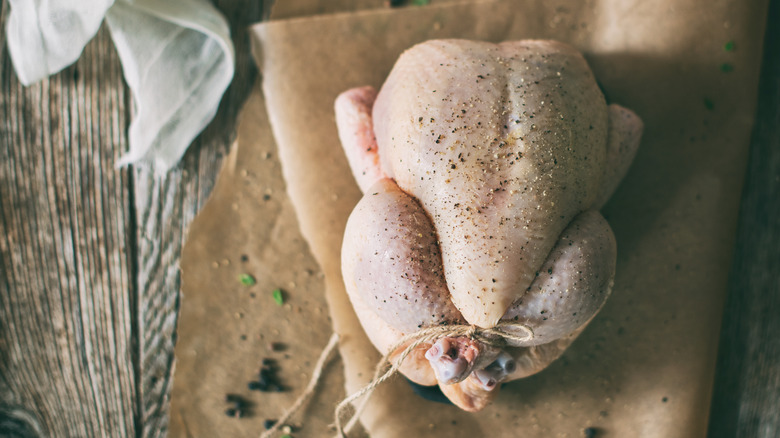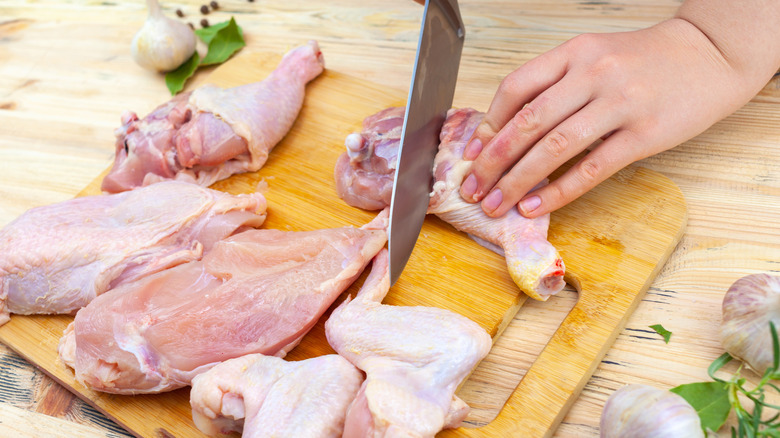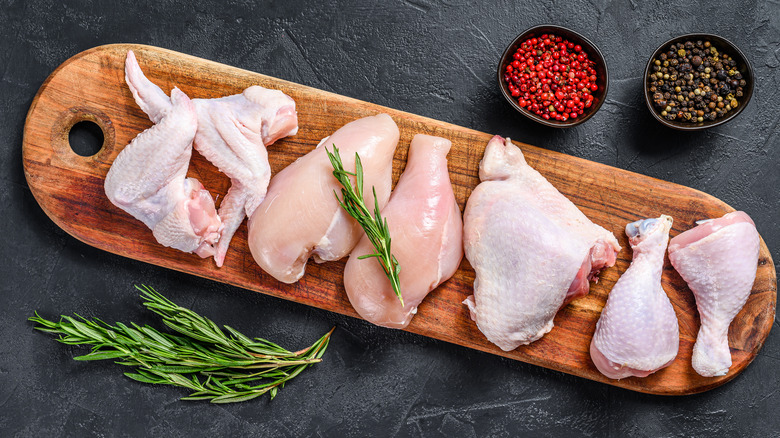The Economical Reason You Should Be Buying Whole Chickens
The idea of buying and cutting up a whole chicken might sound intimidating (remember when Gordon Ramsay did it while literally blindfolded?), but learning this essential kitchen skill has a ton of benefits. Not only will you have a really cool party trick, but carving your own chicken will also be nice for your wallet. In fact, it's cheaper to buy a whole chicken and butcher it yourself thanks to the lower price per pound — and who doesn't want to save a few bucks on groceries?
Buying whole chickens also opens up your kitchen to so many possibilities. You can make exciting recipes using unique chicken parts (hello, Southern fried chicken livers), and even learn some other poultry skills, like butterflying or spatchcocking your bird. Additionally, you can keep the carcass to make homemade chicken stock, bone broths, and demi-glaces (another economical benefit when buying it whole).
While this shopping tip is cost-effective, it may also make you a better cook. Not only will you be carving up your chicken blindfolded in no time (just kidding, let's save that for the professionals), but you'll also have the opportunity to learn how to cook with a constant rotation of different chicken parts. This practice will help you get more creative in the kitchen, and who doesn't want another reason to impress their friends with an epic chicken-centered and stress-free dinner party?
How many pieces are in a whole chicken?
The first time you bring your whole chicken home, you might be wondering where to start — and if you need a fancy butcher's coat. (While they look cool, they aren't necessary.) You'll just need yourself, a cutting board, and a sharp chef's knife to do the trick, although a good pair of kitchen shears wouldn't hurt to have on hand, too.
If you're just getting started, cutting your bird into six, eight, or 10 pieces (depending on whether or not you divide the breasts and legs) is your best bet — although some butchers cut a chicken into as many as 15 pieces. When going the eight-piece route, you can expect to get two breasts, two thighs, two drumsticks, and two wings out of the bird, with a neck and spine to use for homemade chicken stock.
While watching a detailed video may be a good way to help you learn how to cut up your whole chicken, there are also plenty of articles that use photos to help you visualize the skill, too. No matter which way you like to learn, getting practice in your own kitchen will help you become a chicken-carving master in no time.
A run-through of different chicken pieces
The leanest part of the chicken, coming in at only 3 grams of fat per 3 ounces, is the chicken breast. It offers all white meat and comes packed with protein (26 grams per 3 ounces), so it's perfect when you're looking for a healthy meal. There are also tons of chicken breast recipes to explore and try, so you'll never get bored.
The thigh is another popular part of the chicken. It's all dark meat and is a bit fattier than the breast at 9 grams of fat per 3 ounces and also offers 20 grams of protein, so it cooks up beautifully juicy and tender. There are a variety of chicken thigh recipes to choose from, one of our favorites being cider-braised chicken thighs.
If you keep the thigh attached to the drumstick while butchering, you've got another dark meat option: chicken legs. But you can also separate them to make yummy drumstick recipes, like sweet chili chicken lollipops. The drumstick itself has 5.5 grams of fat per 3.5 ounces and 23.5 grams of protein.
Chicken wings are a fun cut that is actually made up of three parts: the drumette, the wingette, and the tip. They're usually found on the table at many Super Bowl parties, and while it's kind of hard to nail down their nutrients because there are so many ways to cut them, a boneless, skinless wing comes in at 1.9 grams of fat and 6.4 grams of protein per 3.5 ounces.



